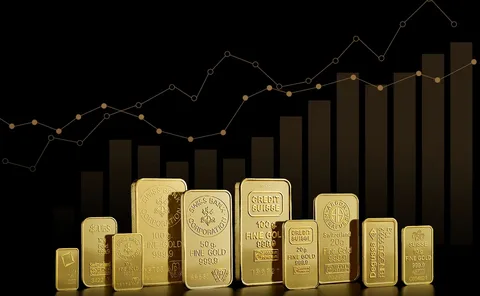The price of gold has been on the rise due to a surging demand, causing a spike in its value. As the demand for gold continues to increase, so does its price. This trend has sparked a significant increase in the price of gold, impacting various industries and economies around the world. In this article, we will explore the factors driving this surge in demand and its implications for the price of gold.
The surging demand for gold has caused a recent spike in the price of the precious metal. This increased demand is driving up prices as investors seek out safe-haven assets amidst global economic uncertainty. Factors such as geopolitical tensions, inflation concerns, and a weaker US dollar have all contributed to the growing interest in gold as a store of value. Additionally, the ongoing COVID-19 pandemic has further fueled demand for gold as investors look for ways to protect their wealth in uncertain times. As a result, gold prices have reached new highs, and the trend is expected to continue as long as these market conditions persist.
The Fluctuating Nature of the Price of Gold

The price of gold has always been a topic of interest for investors, economists, and individuals looking to purchase precious metals. From historical trends to current forecasts, the price of gold is impacted by a variety of factors, including global economic uncertainty, inflation, and market speculation. As a safe haven investment, the price of gold tends to fluctuate in response to geopolitical events and economic stability. Understanding these factors can help individuals make informed decisions when it comes to buying or selling gold.
The price of gold fluctuates due to various factors including supply and demand, geopolitical events, economic trends, and market speculation. Gold is considered a safe haven investment during times of economic uncertainty, which can drive up its price. Additionally, central bank policies and interest rates can influence the price of gold. The current COVID-19 pandemic has also impacted the price of gold, as investors seek out safe assets in times of financial instability. Overall, the price of gold is influenced by a complex range of factors and can be highly volatile.
Understanding the Factors that Impact Gold Prices

Understanding the factors that impact gold prices involves considering a range of economic, geopolitical, and market-related factors. These may include inflation rates, central bank policies, currency fluctuations, interest rates, and investor sentiment. In addition, supply and demand dynamics, as well as changes in global trade and political tensions, can also play a role in shaping the price of gold. By analyzing these various factors, investors and analysts can gain insights into the potential trajectory of gold prices and make informed decisions about buying, selling, or holding onto gold assets.
Investing in Gold: Is Now the Right Time?

Investing in gold is a popular choice for many investors as it is often seen as a safe haven during times of market instability. The right time to invest in gold can depend on a variety of factors including the current state of the economy, geopolitical events, and inflation rates. Some experts believe that now could be a good time to invest in gold due to concerns about potential inflation and economic uncertainty. However, it’s important to carefully consider your own investment goals and risk tolerance before making any decisions. Additionally, it’s advisable to seek guidance from a financial advisor or do thorough research before investing in gold or any other asset.
Gold Price Forecast: What the Experts are Saying
See also: detector metal

Gold price forecast varies among experts, but many are predicting a bullish trend in the coming years. Some analysts believe that the economic uncertainty caused by the pandemic, along with geopolitical tensions and inflation concerns, will drive up demand for gold as a safe haven asset. Others point to the potential for a weaker US dollar and low interest rates as supporting factors for higher gold prices. Overall, the consensus among experts is that gold will likely see sustained growth in the near future.
The Historical Trends of Gold Prices: What to Expect
The historical trends of gold prices have shown that the value of gold has been relatively stable over long periods of time, with occasional periods of rapid increases or decreases in value. Factors such as geopolitical tensions, economic instability, and currency fluctuations have historically led to increases in the demand for gold, driving up its price.
In recent years, gold prices have experienced an overall upward trend, as investors seek to diversify their portfolios and hedge against inflation and economic uncertainty. This trend is expected to continue as the global economy remains volatile and geopolitical tensions persist.
However, it’s important to note that while historical trends can provide insights into potential future price movements, they do not guarantee future performance. As with any investment, it’s important to conduct thorough research and consider the advice of financial professionals before making any decisions.
Is the Price of Gold a Reliable Indicator of Economic Health?
The price of gold is not always a reliable indicator of economic health. While it is often seen as a safe-haven asset, its price can fluctuate due to various factors such as geopolitical tensions, inflation, and currency movements. Therefore, it should be used in conjunction with other economic indicators to get a complete picture of the economy.
Gold: A Safe Haven Investment in Times of Uncertainty
Gold has been considered a safe haven investment during times of uncertainty for centuries. Investors turn to gold as a way to protect their wealth during economic and geopolitical instability. The precious metal is seen as a store of value and a hedge against inflation, currency devaluation, and stock market volatility.
Historically, gold prices have tended to rise during times of crisis or uncertainty, as investors seek out the relative stability and security that gold offers. This was evident during the 2008 financial crisis, as well as during geopolitical tensions and economic downturns.
Gold is also considered a reliable diversification tool for investment portfolios, as it often behaves differently than other asset classes such as stocks and bonds. This can help reduce overall portfolio risk and volatility.
Additionally, central banks around the world hold significant amounts of gold as part of their foreign exchange reserves, which further underscores the metal’s role as a safe haven asset.
Overall, gold’s reputation as a safe haven investment during times of uncertainty is supported by its long history, its recognized value as a store of wealth, and its ability to act as a hedge against various economic and geopolitical risks.
Exploring the Relationship Between the Price of Gold and Inflation
The relationship between the price of gold and inflation has been a topic of interest for economists and investors. Gold is often considered a hedge against inflation, as its value typically increases when the purchasing power of currency declines. This is because gold is seen as a store of value and is not subject to the same risks of devaluation as fiat currencies. As inflation rises, investors may turn to gold as a way to protect their wealth. Conversely, when inflation is low, the price of gold may not see as much upward movement. Studying the correlation between the price of gold and inflation can provide insights into the impact of economic conditions on the precious metal’s value. Various factors, such as interest rates, market sentiment, and geopolitical events, can also influence the relationship between gold prices and inflation. Understanding this relationship can be valuable for making investment decisions and managing risk.
Should You Buy Gold Now? Analyzing the Current Prices
Investing in gold can be a smart move in uncertain economic times. With current global economic instability, many investors are turning to gold as a safe haven for their wealth. Gold prices tend to rise during times of economic uncertainty and inflation, making it a valuable asset to hold in a diversified investment portfolio.
It’s important to carefully analyze current gold prices and market trends before making any investment decisions. Look at factors such as demand for gold, geopolitical tensions, and central bank policies to determine if it’s the right time to buy.
Keep in mind that gold prices can be volatile and it’s essential to consider your own financial goals and risk tolerance before investing. Consulting with a financial advisor can also provide valuable insight into whether now is a good time to buy gold.
The Psychology of Gold Prices: Why Do They Fluctuate?
The psychology of gold prices is influenced by a variety of factors, including supply and demand, geopolitical events, economic indicators, and investor sentiment. Gold is often seen as a safe haven in times of uncertainty, leading to increased demand and higher prices during periods of instability. Conversely, when confidence is high and markets are performing well, the appeal of gold diminishes, leading to lower prices.
Additionally, behavioral psychology plays a significant role in gold price fluctuations. Investors’ emotions, biases, and cognitive errors can impact their decision-making, leading to herd behavior and overreactions to news or market movements. This can result in exaggerated price swings as investors buy or sell based on fear or euphoria rather than a rational assessment of underlying value.
Overall, the psychology of gold prices is a complex interplay of economic, geopolitical, and psychological factors that can lead to significant fluctuations in the market.
price of gold
The price of gold is subject to various factors such as supply and demand, investor sentiment, geopolitical events, and inflation. As a result, the price of gold can fluctuate on a daily basis. It is typically quoted in troy ounces and is widely used as a store of value and a hedge against inflation. Gold prices can be influenced by economic indicators, central bank policies, and market speculation. Additionally, the price of gold is also impacted by jewelry demand, industrial uses, and central bank purchases. Overall, the price of gold is a complex and dynamic market that is influenced by a wide range of factors.
In conclusion, the surging demand for gold has caused a significant spike in its prices, making it a popular investment choice for many. As a result, the price of gold is expected to remain high in the near future as demand continues to outpace supply.
See also
https://www.veracash.com/fr/cours-or
https://www.bdor.fr/cours-or
https://www.gold.fr/